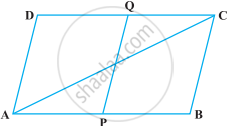Advertisements
Advertisements
प्रश्न
The point of intersection of diagonals of a quadrilateral divides one diagonal in the ratio 1:2. Can it be a parallelogram? Why or why not?
उत्तर
No, it cannot be a parallelogram because the diagonal of a parallelogram are always bisect each other i.e. in the ratio 1:1.
APPEARS IN
संबंधित प्रश्न
Diagonals of a parallelogram `square`WXYZ intersect each other at point O. If ∠XYZ = 135° then what is the measure of ∠XWZ and ∠YZW?
If l(OY)= 5 cm then l(WY)= ?

Diagonals of a quadrilateral ABCD bisect each other. If ∠A = 35º, determine ∠B.
Points P and Q have been taken on opposite sides AB and CD, respectively of a parallelogram ABCD such that AP = CQ (Figure). Show that AC and PQ bisect each other.

In a parallelogram ABCD, AB = 10 cm and AD = 6 cm. The bisector of ∠A meets DC in E. AE and BC produced meet at F. Find the length of CF.
A diagonal of a parallelogram bisects one of its angles. Show that it is a rhombus.
In the following figure, AB || DE, AB = DE, AC || DF and AC = DF. Prove that BC || EF and BC = EF.

If the diagonals of a quadrilateral bisect each other, it is a ______.
If diagonals of a quadrilateral bisect each other, it must be a parallelogram.
Two sticks each of length 5 cm are crossing each other such that they bisect each other. What shape is formed by joining their endpoints? Give reason.
